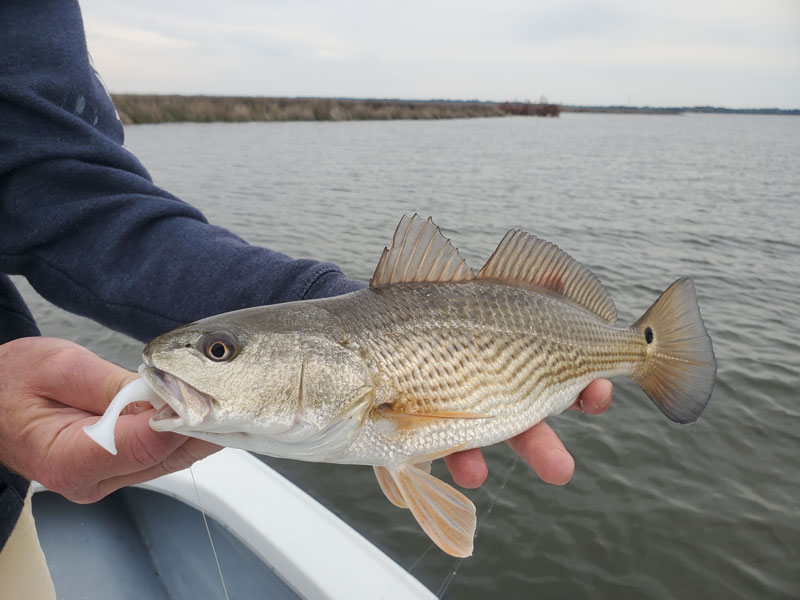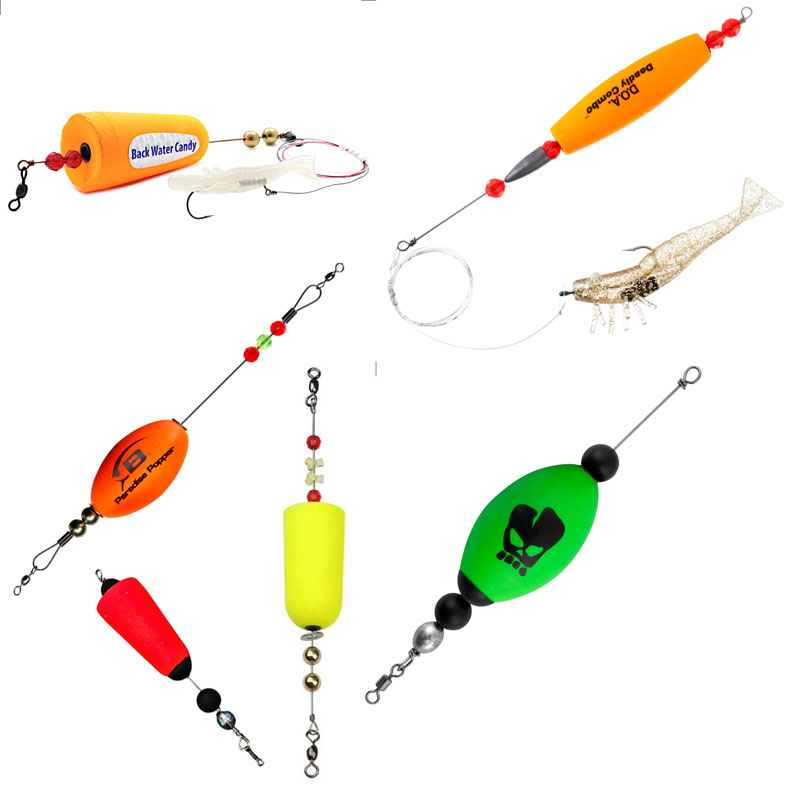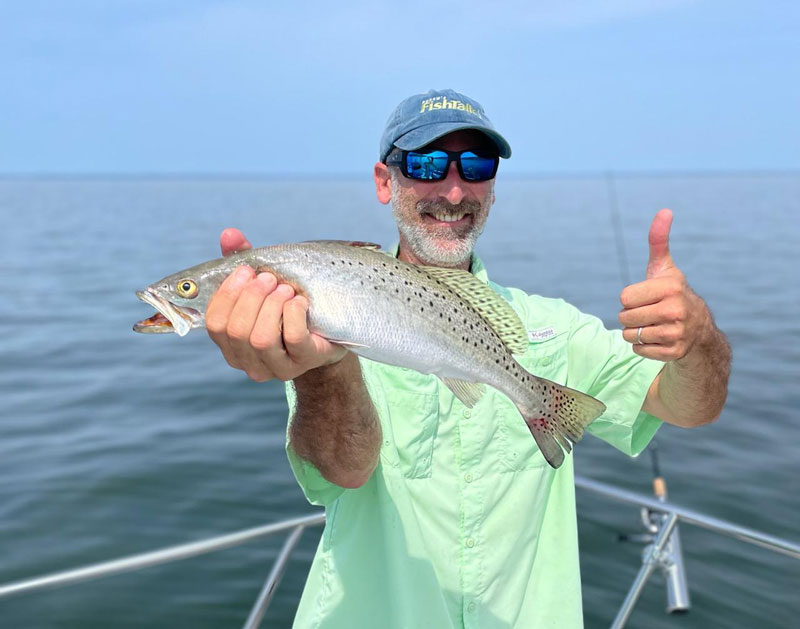Fishing with popping corks hasn't always been a mainstay for Chesapeake anglers, but in recent years the changing Bayscape has led to a greater intermingling of northern and southern species than Chesapeake dwellers have ever seen before. From the Chesapeake Bay Bridge clear down to the CBBT, shallow water anglers might pick up a combination of redfish, striped bass, and speckled sea trout on any given day. And since these three predators all enjoy slurping up the same sorts of goodies, you might catch any one of the three while casting lures like soft plastics, small spinnerbaits, jerkbaits, or even topwater. Another option that shines in certain scenarios is fishing a popping cork, a southern technique which has tremendous popularity in Virginian waters and in recent years has been catching on more and more in Maryland as well.

What is a Popping Cork?
A popping cork is essentially a big foam bobber that has a tube in the middle with a stiff wire running through it, and beads that slide on the wire above and below the cork. The cork slides freely up and down the wire. When an angler jerks the line to “pop” the cork, it slides back and forth banging the beads. This creates a clicking and clacking sound. Some popping corks also have a concave top, so they pop or chug more or less like a topwater popper.
As you might expect, all that clicking, clacking, chugging commotion is believed to draw the fish’s attention. And tied two or three feet below that cork is your offering, following said commotion. The predator heads for the action, sees the lure, and attacks—or so we hope. When the cork gets pulled under the water’s surface, you know to set the hook and the fight is on.
While there are a million and one theories out there about how and why popping corks are so effective, listening to underwater recordings of predator fish feeding can prove illuminating. Odd as it seems the dominant sound is mostly clicking and clacking, which many people believe is the reason why lures with rattles inside can prove so productive. The science on this is limited and some researchers have claimed that most of the noise made by rattling lures is outside of the fish’s hearing range, so we’re not about to stake any claims as to the facts behind the function. But one thing is for sure: popping corks do in fact work.

How to Rig a Popping Cork
A loop is bent into each end of the popping cork’s wire, giving you top and bottom attachment points. You can use a swivel or quick-clip but most anglers will tie their mainline directly to the top loop, then tie their leader to the bottom loop. Choose leader length according to water depth or, when fishing over weedbeds, the depth over the weeds. Most of the time two or three feet will be best, though sometimes leaders as short as 18” or as long as four feet will prove ideal. Most of the time 15-pound test is plenty of strength for the leader, though some anglers bump it up to 20 or even 25 if large fish are around.
What you tie onto the end of that leader is a matter of great debate. Many anglers choose either a three-or four-inch paddletail on a quarter-ounce to half-ounce jighead. Many others use plastic shrimp. And some anglers opt for the real thing and use fresh shrimp or live minnow on a jig head.
You’ll notice that popping corks come in all sorts of bright colors, and it’s a good idea to get a few different ones. Cork color usually won’t make a difference to the fish, but it will make it easy for you to ID which rig is which and quickly switch between them as you fish different rods. Sometimes something as subtle as a few inches of leader length or a different jig head can make a difference, and if all your corks are the same it can be hard to tell one rig from the next.
How to Fish a Popping Cork
When fishing the shallows for fish like reds, specks, and rock, the traditional southern tactic works great: two or three pops followed by a pause. The length of the pause is generally three to five seconds, and this is usually when the strike will come. If that cork takes a dive, set the hook immediately.

Try faster and slower cadences through the course of a day because at different times and in different places fish will respond more or less to a cork that’s fished faster or slower. When you get a strike try to mimic the cadence you were using, and keep experimenting until you can nail down the cadence that the fish want most at any given time.
Popping corks can also be incredibly effective on Spanish mackerel, bluefish, and stripers when these fish are schooled up and breaking water, but in this scenario speed up the retrieve and forget about the pause entirely. Instead, cast out as far as possible then crank the cork back at fast speeds while constantly popping. But if mackerel and blues are in the mix make sure you swap out that lure for something that’s bite-proof, first, or they’ll slice and dice their way through a bag of tails in short order.
When to Fish Popping Corks
Popping corks can work in most shallow water fishing scenarios, but where they shine the brightest is fishing around weedbeds. Often it’s impossible to fish a jig or plug effectively over weedbeds without becoming fouled. Sometimes you can rip an offering across the surface and keep it out of the weeds, but you may need to retrieve faster than optimal to do so. Instead, tie on that popping cork and trim the leader so your offering is suspended just above the top of the weeds. You’ll rarely become fouled, and that pop-pop-pause allows you to work the lure along at a reasonable pace.
Another prime scenario for popping corks is casting around shallow oyster bars or similar structure. Again, the key feature is that it keeps your lure or bait near the target depth without becoming fouled.
As for open-water use, save the corks until you see fish thrashing on the surface. Generally speaking it will only prove effective when fish are schooled up and breaking, and you know where to cast to bring the cork right through the frenzy.
Okay: are you ready to catch more of those reds, specks, and rock? You have lots of options to make it happen, and one you don’t want to miss out on is tossing a popping cork—no matter where in the Bay you do your casting.
Added Bonus! Popping corks come with an added advantage over most other options you might pick: they add an ounce or two to the overall rig, so you can cast them a country mile.